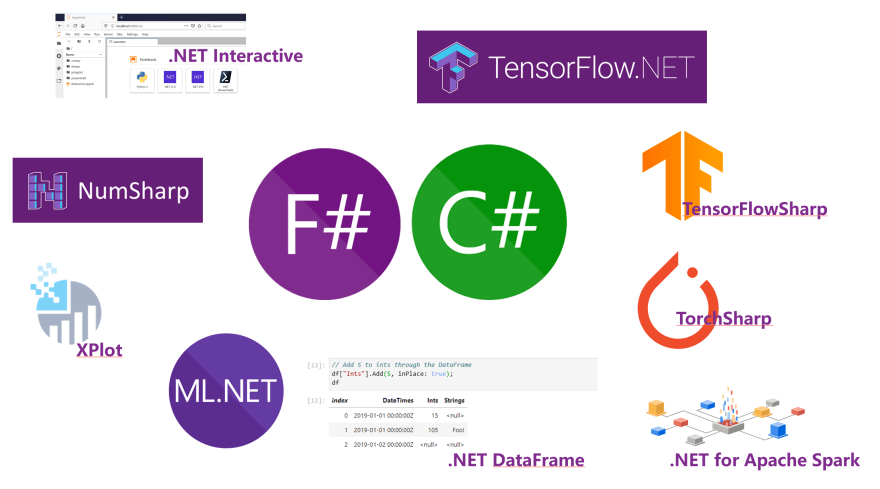An Interest In:
Web News this Week
- April 24, 2024
- April 23, 2024
- April 22, 2024
- April 21, 2024
- April 20, 2024
- April 19, 2024
- April 18, 2024
.NET Core In Artificial Intelligence Series-Overview
Hi .NET Developer, this is a series of how to complete artificial intelligence applications under .NET Core, and hope to provide a guide for .NET Developer to enter the field of artificial intelligence.
.NET Core is already a technology stack solution for full-scene applications, with support for every field. Since Microsoft's efforts in open source, the community capabilities of .NET Core have also been supplemented.
Artificial intelligence is a global hotspot. In artificial intelligence, the Python language is the first world. There are many technical barriers for many .NET programmers to enter this field. Of course, some people will mention why we need to use .NET for machine learning? For a team, there is technical continuity. If you want to invest in a new field, you must ensure the technical cost. If you want to recruit a Python team, it will cost a lot. What can be done with the original technology is the best solution, and it can continue the creativity of the original team. It is also very good for individuals to better apply the experience accumulated in the past in new fields.
What can .NET Core do in artificial intelligence at this stage? How is the ecology? The following are some related technologies in native .NET Core artificial intelligence scenarios
.NET Interactive
In traditional data science, data scientists like to use Jupyter Notebook as the main environmental tool. (Jupyter notebook is a web application that allows users to combine explanatory text, mathematical equations, code, and visual content into one easy-to-share document.) .NET Interactive is an extension of Jupyter Notebook that allows .NET Developers to work in Jupyter Use C#/F# to do data-related work on Notebook.
NumSharp
In Python, we need to use Numpy to do a large amount of data processing, complete matrix operations, and multi-dimensional data conversion. NumSharp is an open source .NET Core version of Numpy provided by a third party. (Github https://github.com/SciSharp/NumSharp)
.NET DataFrame
In data science, data analysis is a very important part, and Pandas is an important tool in the Python scenario. For .NET Core, data analysis is done through DataFrame, allowing you to understand and adjust data faster.
XPlot
Through XPlot, you can generate different charts from the data and find out the characteristics of the data.
.NET for Apache Spark
.NET Core natively supports Apache Spark for big data processing
ML.NET
ML.NET is Microsoft's machine learning framework, which provides an easy way to train, create, and run models in the .NET ecosystem. This is great news for .NET developers, because it allows you to reuse all the knowledge, skills, code, and libraries you already have as a .NET developer. However, this is not just a framework for .NET developers. In fact, ML.NET has proven itself to be a great end-to-end tool that enables any developer to create complex pipelines and bind to different data sources.
TensorFlow.NET
TensorFlow.NET (TF.NET) provides .NET Standard bindings for TensorFlow. It aims to implement a complete Tensorflow API in C#, allowing .NET developers to use the cross-platform .NET Standard framework to develop, train, and deploy machine learning models. TensorFlow.NET has built-in Keras high-level interface and is released as an independent package TensorFlow.Keras. (Github https://github.com/SciSharp/TensorFlow.NET)
TensorFlowSharp
TensorFlowSharp is a TensorFlow model runtime. Compared with TensorFlow.NET, it lacks many functions such as graph calculation and training. (Github https://github.com/migueldeicaza/TensorFlowSharp)
TorchSharp
TorchSharp is a .NET library that provides access to libraries that support PyTorch. (Github https://github.com/xamarin/TorchSharp)
Through the above-mentioned native libraries, you can complete related technologies through C#/F#. This series will start with the most basic knowledge, including environment construction, basic concepts, machine learning related algorithms, and deep learning, hoping to make .NETer more Good to learn the knowledge of artificial intelligence.
ps:The book update is also synchronized on Github (https://github.com/kinfey/DotMLBooks)
Original Link: https://dev.to/kinfey/net-core-in-artificial-intelligence-series-overview-3i5f
Dev To
 An online community for sharing and discovering great ideas, having debates, and making friends
An online community for sharing and discovering great ideas, having debates, and making friendsMore About this Source Visit Dev To

